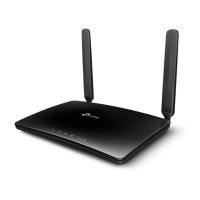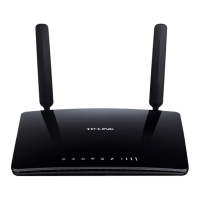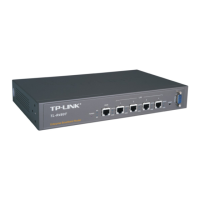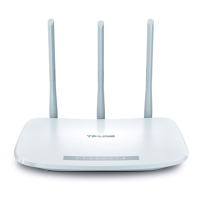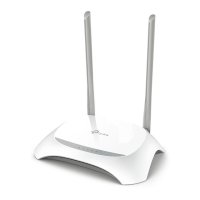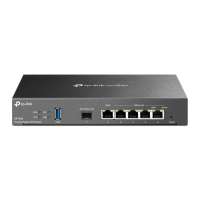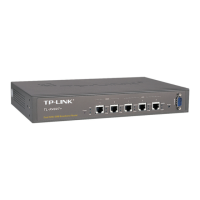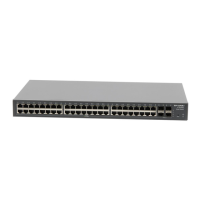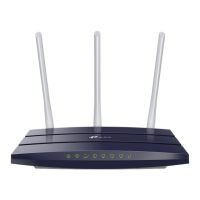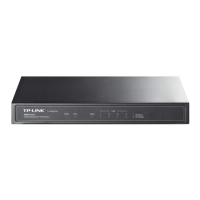Do you have a question about the TP-Link TL-MR150 and is the answer not in the manual?
The router shares the latest generation 4G LTE network with multiple Wi-Fi devices, providing wired and wireless access.
Details the router's front and back panels, including LED explanations and port descriptions.
Provides guidance on optimal router placement for signal strength and performance.
Step-by-step instructions for installing SIM card, connecting power, and connecting to a computer.
Guides users through a quick setup process for internet connection using ISP parameters.
Instructions for manually creating an internet connection profile if ISP settings are not auto-detected.
Explains how to set up IPv6 tunneling mechanisms like 6to4 and 6rd for IPv6 resource access.
Describes how to use the router's diagnostic tool to check internet connection status.
Instructions for creating a TP-Link ID to manage cloud devices and the router remotely.
Guides on modifying the email address and password associated with a TP-Link ID.
Explains how to add, remove, or manage user TP-Link IDs for router access.
Details on using the TP-Link Tether app for smartphone/tablet management of the router.
Covers enabling SPI Firewall and DoS Protection to prevent various network attacks.
Allows users to prevent specific users from accessing services or block internet access completely.
Enables blocking or allowing specific client devices to access the network using blacklists or whitelists.
Prevents ARP spoofing and attacks by binding device IP addresses to MAC addresses.
Protects the IPv6 network by limiting access from the internet and allows configuring inbound rules.
Instructions for viewing received SMS messages in the inbox.
Guides on composing and sending new SMS messages through the router.
How to view messages that have been sent from the router.
Accessing and managing unsent messages saved as drafts.
Configuration options for SMS features, including the message center number.
Steps to set up a separate Wi-Fi network for guests to protect the main network.
Options to configure guest network security, privacy, and client isolation.
Explains Application Layer Gateway (ALG) for customized NAT traversal and protocol support.
How to make local services, like websites, accessible from the internet via port forwarding.
Configures triggering ports that dynamically open external ports for applications like games.
Setting up a device as a DMZ host to allow unrestricted internet communication.
Enabling UPnP for automatic port opening to facilitate online gaming and other applications.
Instructions to upgrade ISP information files to improve internet detection and configuration.
How to use USSD codes to communicate with the service provider for data queries.
Managing SIM card PIN settings, including PIN Lock and Auto-unlock PIN options.
Configuring data limits, usage alerts, and monitoring real-time data consumption.
Customizing the router's LAN IP address, subnet mask, and DHCP server settings.
Configuring wireless network name (SSID), password, security, mode, channel, and transmit power.
Configuring DDNS to access the router remotely using a domain name instead of a dynamic IP address.
Setting up predefined paths for network traffic to reach specific hosts or networks.
Guides on configuring OpenVPN and PPTP VPN servers for secure remote access.
Configuring the router's system time, essential for features like Parental Controls and schedules.
Instructions for updating the router's firmware via online or local methods for performance and security.
Procedures for backing up router settings to a file and restoring them or resetting to factory defaults.
Steps to change the login password for accessing the router's web management page.
Controlling which local devices are allowed to manage the router and via which protocols.
Enabling and configuring remote access to the router from the internet.
Options to turn off router LEDs manually or schedule them to turn off during specific periods.
Setting up automatic or manual router reboots to enhance performance and clear cache.
Accessing, viewing, and saving system logs for troubleshooting and monitoring router events.
Using the Traffic Monitor to view and analyze network traffic statistics for LAN, WAN, and WLAN.
Configuring CWMP (TR-069) settings for automatic device management via an Auto-Configuration Server.
Setting up SNMP for network monitoring and management by administrators.
The router shares the latest generation 4G LTE network with multiple Wi-Fi devices, providing wired and wireless access.
Details the router's front and back panels, including LED explanations and port descriptions.
Provides guidance on optimal router placement for signal strength and performance.
Step-by-step instructions for installing SIM card, connecting power, and connecting to a computer.
Guides users through a quick setup process for internet connection using ISP parameters.
Instructions for manually creating an internet connection profile if ISP settings are not auto-detected.
Explains how to set up IPv6 tunneling mechanisms like 6to4 and 6rd for IPv6 resource access.
Describes how to use the router's diagnostic tool to check internet connection status.
Instructions for creating a TP-Link ID to manage cloud devices and the router remotely.
Guides on modifying the email address and password associated with a TP-Link ID.
Explains how to add, remove, or manage user TP-Link IDs for router access.
Details on using the TP-Link Tether app for smartphone/tablet management of the router.
Covers enabling SPI Firewall and DoS Protection to prevent various network attacks.
Allows users to prevent specific users from accessing services or block internet access completely.
Enables blocking or allowing specific client devices to access the network using blacklists or whitelists.
Prevents ARP spoofing and attacks by binding device IP addresses to MAC addresses.
Protects the IPv6 network by limiting access from the internet and allows configuring inbound rules.
Instructions for viewing received SMS messages in the inbox.
Guides on composing and sending new SMS messages through the router.
How to view messages that have been sent from the router.
Accessing and managing unsent messages saved as drafts.
Configuration options for SMS features, including the message center number.
Steps to set up a separate Wi-Fi network for guests to protect the main network.
Options to configure guest network security, privacy, and client isolation.
Explains Application Layer Gateway (ALG) for customized NAT traversal and protocol support.
How to make local services, like websites, accessible from the internet via port forwarding.
Configures triggering ports that dynamically open external ports for applications like games.
Setting up a device as a DMZ host to allow unrestricted internet communication.
Enabling UPnP for automatic port opening to facilitate online gaming and other applications.
Instructions to upgrade ISP information files to improve internet detection and configuration.
How to use USSD codes to communicate with the service provider for data queries.
Managing SIM card PIN settings, including PIN Lock and Auto-unlock PIN options.
Configuring data limits, usage alerts, and monitoring real-time data consumption.
Customizing the router's LAN IP address, subnet mask, and DHCP server settings.
Configuring wireless network name (SSID), password, security, mode, channel, and transmit power.
Configuring DDNS to access the router remotely using a domain name instead of a dynamic IP address.
Setting up predefined paths for network traffic to reach specific hosts or networks.
Guides on configuring OpenVPN and PPTP VPN servers for secure remote access.
Configuring the router's system time, essential for features like Parental Controls and schedules.
Instructions for updating the router's firmware via online or local methods for performance and security.
Procedures for backing up router settings to a file and restoring them or resetting to factory defaults.
Steps to change the login password for accessing the router's web management page.
Controlling which local devices are allowed to manage the router and via which protocols.
Enabling and configuring remote access to the router from the internet.
Options to turn off router LEDs manually or schedule them to turn off during specific periods.
Setting up automatic or manual router reboots to enhance performance and clear cache.
Accessing, viewing, and saving system logs for troubleshooting and monitoring router events.
Using the Traffic Monitor to view and analyze network traffic statistics for LAN, WAN, and WLAN.
Configuring CWMP (TR-069) settings for automatic device management via an Auto-Configuration Server.
Setting up SNMP for network monitoring and management by administrators.
| Ethernet WAN | Yes |
|---|---|
| WAN connection type | RJ-45 |
| Wi-Fi band | Single-band (2.4 GHz) |
| Wi-Fi standards | 802.11b, 802.11g, Wi-Fi 4 (802.11n) |
| Top Wi-Fi standard | Wi-Fi 4 (802.11n) |
| WLAN data transfer rate (max) | 300 Mbit/s |
| Output current | 0.85 A |
| Output voltage | 9 V |
| Power source type | DC |
| Product type | Tabletop router |
| Product color | Black |
| Antennas quantity | 2 |
| Antenna connector type | N-type |
| USB port | No |
| Ethernet LAN (RJ-45) ports | 4 |
| 4G standard | LTE-TDD & LTE-FDD |
| 3G standards | DC-HSPA+, HSPA, HSPA+, UMTS |
| 4G bands supported | 800, 900, 1800, 1900, 2100, 2300, 2500, 2600 MHz |
| UMTS bands supported | 900, 2100 MHz |
| VPN support | PPTP, L2TP, IPSec |
| Cabling technology | 10/100Base-T(X) |
| Networking standards | IEEE 802.11b, IEEE 802.11g, IEEE 802.11n |
| Receiver sensitivity | 11g 54M: -74dBm 11n HT20: -71dBm 11n HT40: -67dBm |
| Ethernet LAN data rates | 10, 100 Mbit/s |
| Ethernet LAN interface type | Fast Ethernet |
| Equivalent Isotropically Radiated Power (EIRP) (@IEEE 802.11n) | 20 dBmW |
| Security algorithms | 64-bit WEP, 128-bit WEP, WPA, WPA-PSK, WPA2, WPA2-PSK |
| Supported network protocols | IPv4, IPv6 |
| Certification | CE, RoHS |
| Browser supported | Internet Explorer 11, Firefox 12.0, Chrome 20.0, Safari 4.0 |
| Windows operating systems supported | Windows 2000, Windows 7, Windows 8, Windows 8.1, Windows 98SE, Windows NT, Windows Vista, Windows XP |
| Storage temperature (T-T) | -40 - 70 °C |
| Operating temperature (T-T) | 0 - 40 °C |
| Storage relative humidity (H-H) | 5 - 90 % |
| Operating relative humidity (H-H) | 10 - 90 % |
| Cables included | LAN (RJ-45) |
| Package type | Box |
| Depth | 141 mm |
|---|---|
| Width | 202 mm |
| Height | 33.6 mm |

